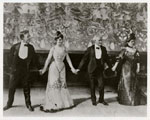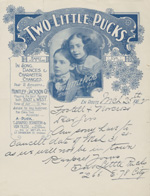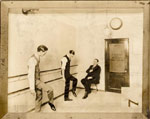The New York
Public Library for the Performing Arts > Vaudeville
Nation
Dance Techniques

The Cohans at curtain
call (from left:
George M.,
Josephine, Jerry (father),
mother) BRTC

Stationery for Harry and
Eva Puck, 1902, a juvenile
song and dance act.
Emerson Collection on
Vaudeville,
Billy Rose Theatre Collection

Ned Wayburn teaching
a tandem dance
team.
White Studio, NY.
The most common Vaudeville act was the song and dance act. It
could be "put over" by any combination of solo, duet, or
team performers. It was especially popular with family acts,
since the children could be included in simple dances, while
learning other techniques.
Vaudeville performers worked in the five basic techniques
of theatrical dance, as codified by dance director Ned Wayburn. Musical
comedy dance (soft shoe) and tap & stepping were the
basic ingredients for any solo or group specialty. Toe work,
from ballet to toe tapping, was popular throughout the vaudeville
era. Exhibition ballroom dance hit its stride in the teens,
with the Fox Trot, One-Step, Hesitation and other "modern" dances. The
standard dance act began with an entrance to as many repeats
of the 4 "Vamp till ready" measures it took to reach the
center of the stage. Two of three individual dances followed,
with an exit sequence.
Ned Wayburn, and others, developed tab shows for children. He
staged the debut act for Fred and Adele Astaire, who were
his students. These acts were most often seen on the Orpheum
circuit of West Coast and Mid-West theaters, since child
performers were illegal in New York State. They include
the various Dainty June acts that toured on the Orpheum circuit
before Dainty June and Rose Louise became June Havoc and
Gypsy Rose Lee.
Tap became distinguishable from tap & stepping in vaudeville,
and popularized both techniques. The development of metal
edged and jingle taps made the audio element more important. Competition,
primarily within the African American troupes, led to the
addition of more and more eccentric and acrobatic movements. This
competition flowered in the late 1920s and 1930s acts of
Bill Robinson, the Nicholas Brothers, Nicodemus, and many
others.
For teams, acrobatic, eccentric or characterization elements
could be added to any of these techniques to develop a specialty. Tandem
acts, often staged for twins or similar siblings, added shadowing
or mirroring to any of the techniques.
Acrobatic work could range from ballet to circus lifts to
living statuary to such characterizational dances as the
Apache (for Parisien gangsters), or Tango, popularized by
Rudolf Valentino. Dance teams of differing heights could
develop acrobatic movements into rag doll dances. Eccentric
or "flash" elements, such as a ear hugging hitch kick, splits,
humps or lifts, could be added to tap or duet work.
Related Images